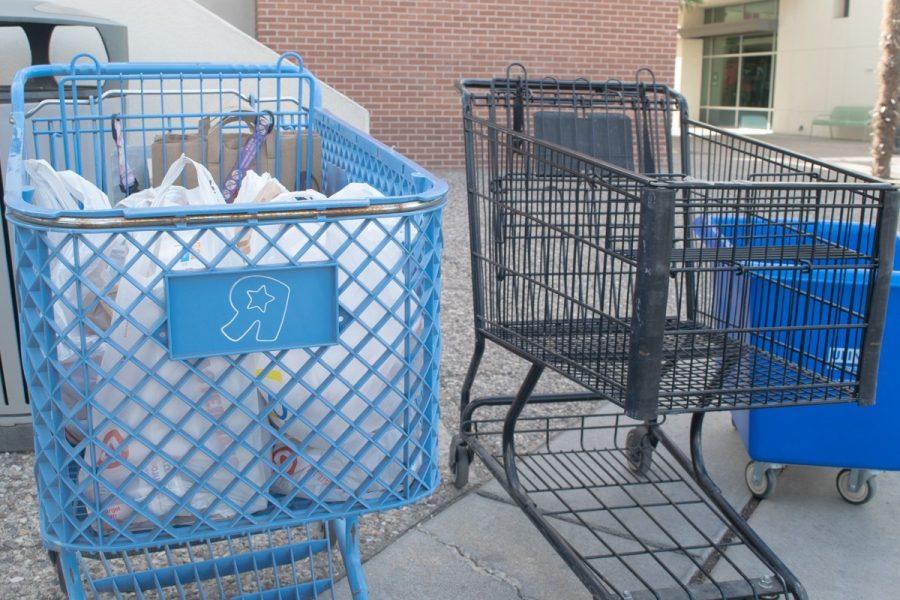The Daily Wildcat sat down with Bridgette Nobbe, coordinator of Campus Pantry and Campus Closet, to learn more about Campus Pantry and the vital role it plays in combating food insecurity on campus.
This article is the third in a series of three profiling the University of Arizona’s Campus Pantry. It answers questions about how the pantry has fared during the COVID-19 pandemic, what has changed and more.
RELATED: All of your campus pantry questions, answered: The basics
How has the COVID-19 pandemic changed the way Campus Pantry operates?
“While some programs around campus had the ability to choose whether or not they would go remote, for us there is not a remote answer to food insecurity,” Nobbe said. “At the end of the day, we’re going to have to be present physically in some capacity.”
The pantry decided against pre-bagging food because it wouldn’t be able to keep up with demand, as the UA’s pantry serves a greater number of students than most other college pantries. The pantry does observe social distancing and other public health measures, which is why it recently moved to the Sonora room in the Student Union Memorial Center.
During the pandemic, instead of selecting their own food, students point to and say what they want from behind a Plexiglass wall. Like in all campus buildings, masks are required on university property.
How has attendance at food distributions changed?
According to Nobbe, in the first half of the spring semester, Campus Pantry served 1,427 unique visitors over the course of 24 distributing days. In the second half of the spring semester, once COVID-19 cases began to surge, the pantry only had 715 users over the course of 26 distributing days. The number of enrolled students served dropped from 1,262 to 509, respectively.
The pantry usually serves 1,900 to 2,000 unique visitors per semester, according to Nobbe. When the Daily Wildcat spoke with her in March 2020, she said that the pantry was only seeing about 700 visitors.
Why are more university staff using the pantry?
Before the COVID-19 pandemic, specifically from Jan. 1, 2020, to March 10, 2020, staff and other non-student pantry visitors made up 12% of all unique users. For the remainder of the spring 2020 semester, from March 17 to May 13, this demographic increased to make up 29% of unique users, according to the 2019-2020 Campus Pantry Executive Summary.
Nobbe attributes the increase in university staff utilizing Campus Pantry to university layoffs, furloughs and shift reductions.
“Again, that was a lot of those janitorial staff, kitchen staff, and most of those folks were on the list of people that were laid off at this university. If you think of all the restaurants that closed, a lot of those staff, that’s where they were working, or their hours were cut,” Nobbe said. “Those staff who used to work every day from 5 a.m. to like 3 p.m. now work until about 10 a.m. because there’s just not as much stuff to do because there’s not places on campus that are open to sell those items, and so that’s been a huge thing with a lot of these folks. Pay has just been completely cut in half, and so that’s part of the reason that we’ve seen a lot of that increase.”
How has the pandemic affected donations?
Though the COVID-19 pandemic has certainly put a dent in the number of in-kind donations, Nobbe noted that the pantry has actually received more monetary donations than it ever has before.
The decrease in in-kind donations can be attributed to the lack of food drives held in-person throughout the year. The pantry usually holds food drives related to homecoming, club olympics, tailgates and family weekend, all of which were cancelled in 2020.
“Every department on campus did a drive around Thanksgiving,” Nobbe said. “It was like the ‘give back time of year’ around Thanksgiving and December. None of those happened. Spring Fling is a huge drive that we have in April that’s not happening. We didn’t have our annual benefit dinner.”
Where does Campus Pantry stand financially?
“I think ‘breaking even’ is probably the best way to describe it,” Nobbe said.
Though donations are down, so is the number of weekly visitors. Less people using the pantry means less money is spent replenishing it with groceries.
“We are just spending about $1,000 to about $2,000 a week,” Nobbe said. “It’s probably what we spend on groceries right now, but we used to spend about $3,000 to $3,500 a week on groceries, but we have less people now and so that’s partly why we are doing okay.”
Is there concern about the return to full in-person instruction this fall?
“I’d say I’m still worried about it,” Nobbe said.
As user rates return to pre-pandemic levels, the pantry may struggle to keep up with demand.
“It’s pretty privileged, I think, to think that once this is over that they’ll be fine because I think a lot of people really went into their savings account or were in the hole and stuff,” Nobbe said. “I know talking to students, a lot of them have charged way more to their credit card, and I think they’re gonna try to be paying that off more next year.”
Provided they’re held in person this year, Nobbe anticipated an influx of monetary and in-kind donations from events like homecoming and family weekend during the fall 2021 semester.
Editor’s Note: This piece was produced as part of the “Confronting Scarcity Project” – a collection of reporting, commentary, maps, audio and more aimed at destigmatizing and amplifying the conversation around food and basic needs insecurity. This project was produced with students and the university community in mind as part of a collaboration between the Daily Wildcat and the UA School of Journalism’s student media apprenticeship program.
Follow on the Daily Wildcat on Twitter















